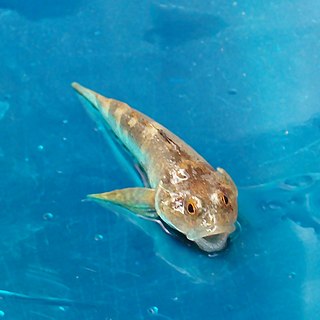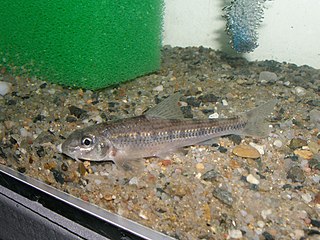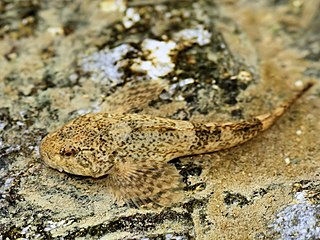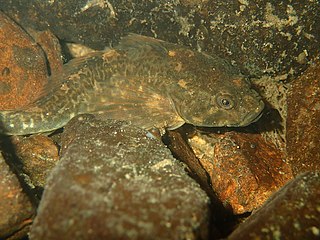
The Kessler's gudgeon is a European species of freshwater fish in the family Cyprinidae. It is found in the Danube and Vistula drainage basins, including parts of Poland, Austria, the Czech Republic, Ukraine, Bulgaria, Romania, Moldova, Hungary, Croatia, Bosnia and Herzegovina, Serbia, Montenegro, Slovakia, and Slovenia. It is a small fish of no economic or sporting importance. It was at one time classified as Gobio kesslerii.

Cottus petiti, also called the chabot du Lez in French, is a species of freshwater ray-finned fish belonging to the family Cottidae, the typical sculpins. It is endemic to France, found only in a small 3 km stretch of the river Lez in Southern France near Montpellier. The natural habitat is fed by karstic springs which may have enabled the isolated survival of the population through geological history. Now the species may be threatened by habitat loss. The males of this species are typically 56 mm in length. This species was confirmed as a separate species from the European bullhead in 2005 by Jörg Freyhof, Maurice Kottelat and Arne W. Nolte. The specific name honours the zoologist and anatomist Georges Petit (zoologie) of the Muséum national d'Histoire naturelle.
The Mitchell gudgeon is a species of fish in the family Eleotridae endemic to the Kimberley region of Australia, where it is only known from the Mitchell River system. This species can reach a length of 4 cm (1.6 in). The specific name honours the ichthyologist J. Barry Hutchins of the Western Australian Museum, who collected the type.
Milyeringa veritas is a species of fish in the family Milyeringidae. It is endemic to groundwater and anchialine systems in caves in the Cape Range, Australia. Like other cave-adapted fish, the blind gudgeon is entirely blind and lacks pigmentation, using sensory papillae on its head and body to move around and find food. It has a reduced number of scales on its body and the head is almost scaleless. It reaches a standard length of 5 cm (2.0 in). It is listed as vulnerable under the Australian Environment Protection and Biodiversity Conservation Act 1999. It is an omnivorous species which feeds on algae and possibly also detritus, as well as invertebrates. Invertebrates consumed by M. veritas include Stygiocaris sp., aquatic insect larvae such as those of caddis flies and non aquatic invertebrates which accidentally fall into the water such as isopods, ants and cockroaches. When the gut contents have been sampled 10% of the identifiable gut contents were Stygiocaris and 70% were terrestrial species, despite this species being restricted to caves. They are often observed hanging still in the water column or resting on ledges in the cave walls, behaviours which they also display when kept in aquaria, but can move quickly to avoid capture if threatened, for example when catching them with a net is attempted. The generic name is taken from Milyering which is 20 miles (32 km) southwest of Vlamingh Head in the North West Cape of Western Australia, the type locality, and the specific name is Latin veritas meaning truth an allusion to a quote attributed to the Ancient Greek philosopher Democritus "Truth lies at the bottom of a well, the depth of which, alas! gives but little hope of release.”
Cottus scaturigo, the Timavo sculpin, is a species of freshwater ray-finned fish belonging to the family Cottidae, the typical sculpins. It is endemic to the Timavo Spring in Italy. This species was described as a separate species from the European bullhead in 2005 by Jörg Freyhof, Maurice Kottelat and Arne W. Nolte. However, the Catalog of Fishes treats this taxon as a synonym of Cottus metae, although FishBase treats it as a separate species. The specific name scaturigo means "spouting water", i.e. a spring, an allusion to the Timavo Spring.
The Soldatov's gudgeon is a species of gudgeon, a small freshwater fish in the family Cyprinidae. It is found in Asia in the Amur River drainage in Russia and China, on the Sakhalin Island, and in Lake Buir in Mongolia. It is a demersal fish, up to 12.0 cm long.

Iberian gudgeon is a species of gudgeon, a small freshwater in the family Cyprinidae. It is widespread only in the Iberian Peninsula where it is indigenous in the Ebro and Bidasoa drainage, and in France in the Adour drainage, as well as Andorra. It has been introduced throughout the Iberian Peninsula, including Portugal, It is a freshwater demersal fish, up to 11.9 cm long.

The Danube whitefin gudgeon is a species of freshwater fish in the family Cyprinidae. It is distributed in the drainage of the Danube river in Europe. The species has been known to reach a length of 11.5 cm (4.5 in); the oldest reported age for the species is 4 years. Its diet includes insect larvae.

The northern whitefin gudgeon is a species of freshwater fish in the family Cyprinidae. It is distributed in the northern Black Sea basin, southern Baltic Sea basin, southern North Sea basin. Also, reports from lakes Ilmen and Ladoga and its basins have been made, which are questionable. Their maximal length is 11.5 cm, with a maximal reported age of 5 years.
Milyeringa justitia, commonly known as the Barrow cave gudgeon, is a species of fish in the family Milyeringidae endemic to groundwater systems (aquifers) of Barrow Island, around 50 km off the Pilbara coast in Western Australia. This troglobitic species has a pale body, lacking in pigment, and it is eyeless and blind, using sensory papillae located on the head and body to allow it to feed and move around in total darkness. The specific name justitia is Latin for "justice" and was given by the describers to complement the specific name of Milyeringa veritas which means "truth" in the hope that “As truth and justice are supposed to go together, we name this species justitia, from the Latin for justice, in the hope that justice helps the species to survive on Barrow Island, which has been an oilfield since 1967 and is most recently the site of the Gorgon Gas Hub development.” Very little is known about M. justitia as between 2002 and 2013 only six specimens were collected but its biology is assumed to be similar to that of M. veritas.

Cottus rondeleti is a species of freshwater ray-finned fish belonging to the family Cottidae, the typical sculpins. This species is endemic to the coastal Hérault drainage of Southern France. The total known distribution comprises three distinct short stretches of stream, and the species considered critically endangered because of threat of drought that is promoted by water extraction and potentially by climate change.

Cottus duranii, the Dordogne sculpin or chabot d'Auvergne, is a species of freshwater ray-finned fish belonging to the family Cottidae, the typical sculpins. It is found in France. It inhabits the Loire and Dordogne river drainages. It reaches a maximum length of 10.0 cm. It prefers streams with clear, cool, moderate to swift water and stone substrate. This species was described as a separate species from the European bullhead in 2005 by Jörg Freyhof, Maurice Kottelat and Arne W. Nolte. The specific name durani means "of Duranius", the Latin name of the River Dordogne.

Cottus rhenanus is a species of freshwater ray-finned fish belonging to the family Cottidae, the typical sculpins. It is found in France, Belgium, Germany, Luxembourg, and the Netherlands. It inhabits the Rhine and Meuse river drainages. It reaches a maximum length of 10.0 cm. It prefers streams with clear, cool, moderate to swift water and stone substrate. Here, it mostly occurs in the shallow parts of streams. This species was described as a separate species from the European bullhead in 2005 by Jörg Freyhof, Maurice Kottelat and Arne W. Nolte. The specific name rhenatus means belonging to Rhenus, the Latin name of the River Rhine.
Cottus metae is a species of freshwater ray-finned fish belonging to the family Cottidae, the typical sculpins. It inhabits the upper Save River system in the Danube basin. It reaches a maximum length of 9.7 cm. It prefers small streams to medium-sized rivers. This species was described as a separate species from the European bullhead in 2005 by Jörg Freyhof, Maurice Kottelat and Arne W. Nolte. The specific name 'honours the Slovenian biologist Meta Povž, in recognition of her assistance to the authors in a variety of projects.

Cottus perifretum, the bullhead or miller's thumb, is a species of freshwater ray-finned fish belonging to the family Cottidae, the typical sculpins. It is found on both sides of the English Channel, native to Great Britain. It also inhabits Atlantic drainages from the Garonne River to the Scheldt in France and Belgium, and the Moselle and Sieg in Germany. It is considered invasive in the Rhine drainage in Germany and the Netherlands. This invasive population in the Rhine is an intermediate between this species and Cottus rhenanus. Although this species is native to England and Wales it is considered to be a non-native invasive species in Scotland.
Cottus transsilvaniae is a species of freshwater ray-finned fish belonging to the family Cottidae, the typical sculpins. It is endemic to Romania in the upper Arges River in the Danube drainage. It reaches a maximum length of 9.7 cm. It prefers rocky shoals and riffles of small upland streams. his species was described as a separate species from the European bullhead in 2005 by Jörg Freyhof, Maurice Kottelat and Arne W. Nolte. The specific name transsilvaniae means "of Transsilvania", the Latin name of the Transylvania.
The Eyilikler gudgeon is a species of gudgeon, a small freshwater in the family Cyprinidae. It is found in Turkey.

The Danube delta gudgeon is a species of cyprinid fish endemic to the lower Danube in Bulgaria, Romania and Ukraine. It was last recorded in the 1960s, with many studies conducted in its home range, all failing to find the species, until in 2016 a specimen was collected from the Bulgarian sector of the Danube.
The South Caucasian gudgeon is a species of cyprinid fish found in the Kura and Aras drainages flowing to the southwest Caspian Sea from headwaters in Turkey down to lower reaches in Azerbaijan and Iran.
Romanogobio parvus is a species of cyprinid fish endemic to the Kuban River in Russia.










